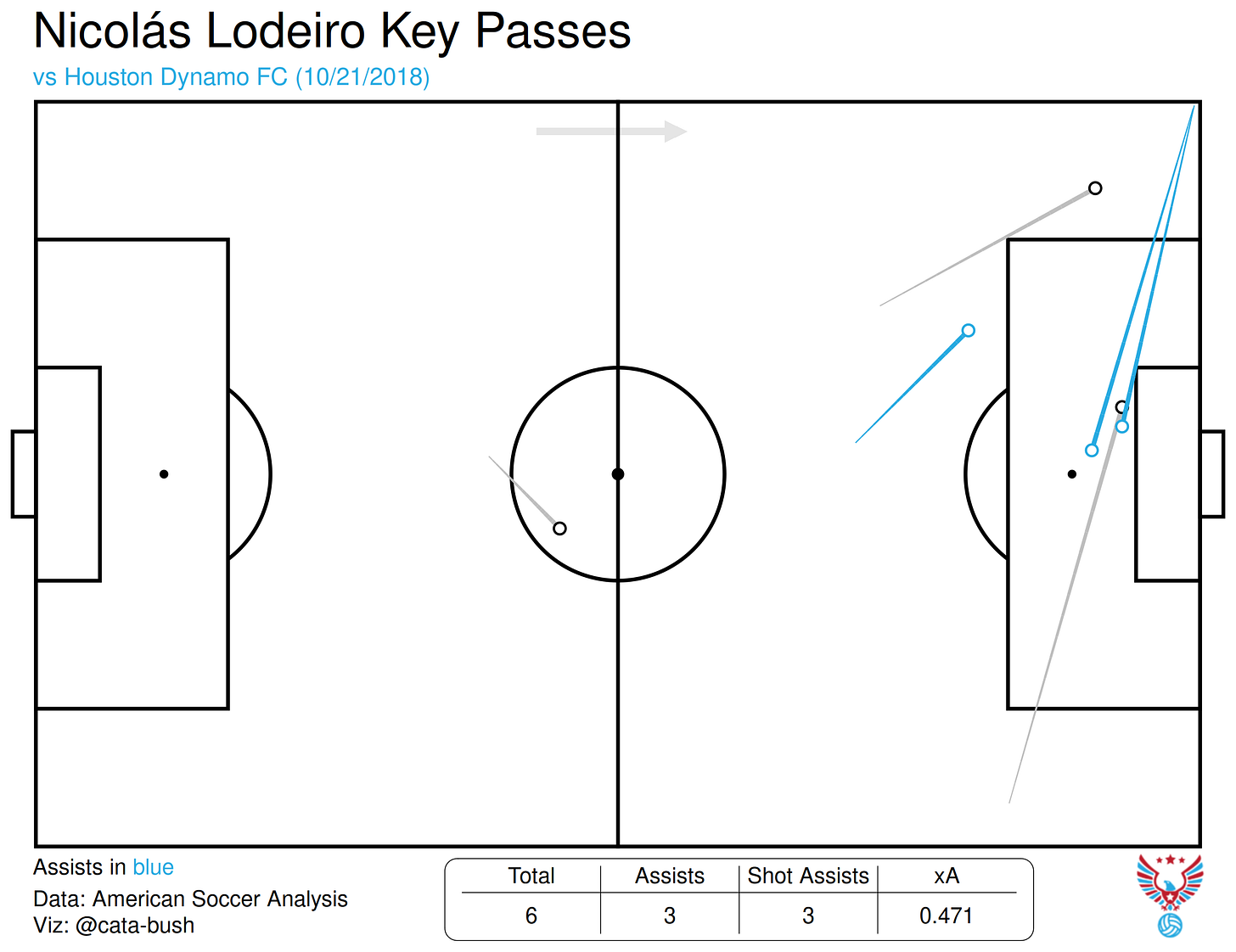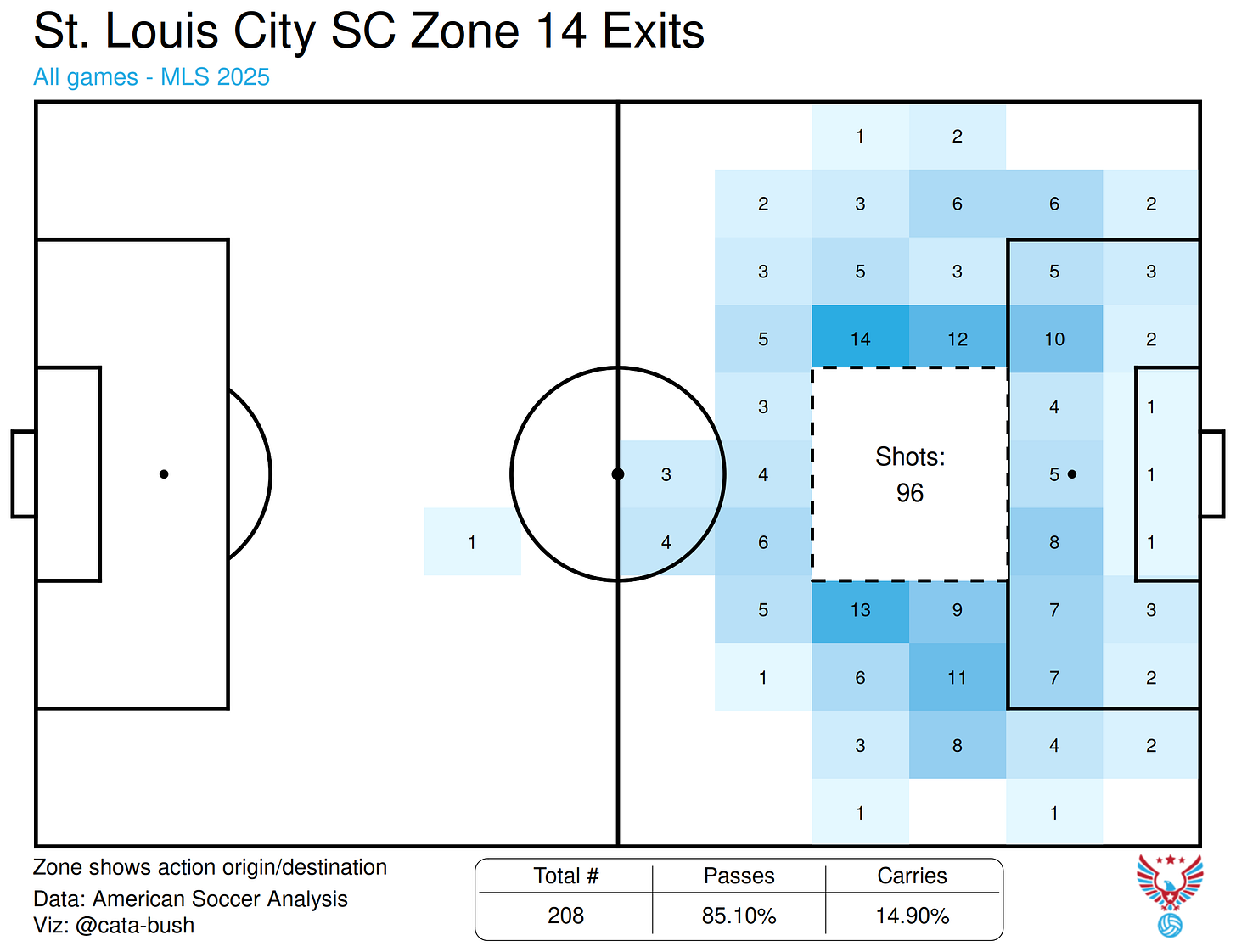What to know in regards to the latest ASA platform
Have you ever ever wished that you may image the sport in entrance of you? Not as a broadcast, or a spotlight video, however on a sheet of paper? All of a midfielder’s passes, your striker’s photographs, an opponent’s tendencies, visualized? Beforehand, that required entry to information, coding data, and hours spent reinventing the wheel, simply to see essentially the most elementary facets of our recreation in graphic kind. Not anymore.
Introducing American Soccer Evaluation’ latest public platform: ASA VizHub. Making use of ASA’s intensive database, VizHub does the exhausting give you the results you want, permitting for straightforward technology of industry-quality graphics.
Need to see Gareth Bale’s MLS Cup-winning objective in 2022? Simple. Interested by Sam Kerr’s participant radar in 2019? No downside. What about Chivas USA’s defensive construction when taking part in with 4 defenders within the 2014 MLS season? Completed. With over 20 distinctive templates and loads of inputs, there are millions of attainable combos to discover.
The perfect half? Similar to the objectives added (g+) tables, VizHub is free, simple to make use of, and updated. You’ll be able to entry VizHub now at viz.americansocceranalysis.com, or on the Viz Hub tab on the prime of the principle website.
With the amount of graphics at your fingertips, we thought it prudent to try each chart out there and provides an explainer on what all of it means. Maintain studying to see the ability of VizHub in motion!
The Platform


The house web page greets you with the sort face of A.J. Cochran, perpetual first-in-line-er. This web page is the place you possibly can generate player-level graphics, which shall be defined in depth in a while on this article. For proper now, let’s dive into how precisely the platform works.
On the left, you’ll see a sequence of league logos. Clicking on one in every of these will change the lively league — this is applicable to all tabs, not simply the participant tab. Clicking on the participant search bar will allow you to browse each participant within the given league, no matter whether or not they’re nonetheless taking part in or not. When choosing a participant, please permit a second for the participant’s data to load in. Notice the crew brand in a blue field above the yr dropdown: all groups the participant performed for within the chosen season will seem right here. Typically, that’s only one crew, but when two seem, you possibly can simply toggle between them (or choose each!) to view the participant’s stats whereas taking part in for that crew in that season. For instance, if a participant was traded mid-season, choosing only one crew will filter the information to simply that portion of the season.
The yr and graphic dropdowns are pretty easy, and beneath them, the season/recreation toggle controls the amount of knowledge included within the graphic. Whereas some charts are solely out there on the season stage, many will be generated on a single-game foundation, as properly. To try this, merely change to the “recreation” mode, and beneath, a dropdown with all the participant’s video games in that season will seem.
It’s vital to regulate this space beneath the season/recreation toggle. Superior choices for charts will seem there relying on which graphic has been chosen. As soon as all choices are chosen, click on “Go” to create your graphic!
The crew tab is pretty just like the participant tab, with a number of issues lacking. Notice that there is no such thing as a season/recreation toggle. As of proper now, all crew graphics are solely out there on the season stage. Like earlier than, merely choose your season and crew, select your graphic, and hit “Go”! Once more, superior choices for graphics will seem beneath the graphics dropdown, so maintain a watch out for these additional controls.
The league tab is possibly essentially the most easy; its operate is to create league-wide scatterplots. Extra data shall be shared relating to this operate in a while, however all you’ll want to know is that the x- and y-variables are simple to alter and shall be mirrored on the chart. You’ll be able to change aesthetic choices by clicking on the sliders to the precise of the y-variable dropdown.
Now, for the precise graphics:
Participant Graphics
Season- and game-level
The entire following charts will be generated each on a person recreation and a whole season stage.
The Shot Chart
The participant shot chart builds off of basic shot map conventions by displaying photographs as circles. Objectives are crammed in whereas all others are empty. The dimensions of the circle is decided by the xG of the chance, whereas the colour refers back to the manner by which that chance took place. The graphic depends closely on the ideas launched in Jamon Moore and Carlon Carpenter’s The place Objectives Come From Venture. For more information on xG tiers and shot patterns, you possibly can learn their unique explainer right here: The place Objectives Come From.
The Go Chart
The cross chart is much more easy. Every line represents a cross, with the vacation spot indicated by a bubble. If the cross line and bubble are blue, then that cross is progressive, that means it moved the ball 25+% nearer to the objective and started within the attacking 60% of the pitch. The whole rely of tried and accomplished passes is proven within the desk beneath (incomplete passes aren’t plotted) alongside numbers displaying what number of passes have been accomplished above/beneath anticipated and what the entire passing g+ was for this participant within the given match/season.
The Key Go Chart
The important thing cross chart follows the rules defined above, with the caveat that passes highlighted in blue are not progressive, however relatively symbolize major assists. Each different cross proven on this graphic may have assisted a shot, however that shot won’t have been a objective. The related numbers and anticipated assists (xA) of those photographs are proven within the desk.
The Carry Chart
The carry chart is equivalent to the cross chart, however as a substitute of displaying development by way of passing, it reveals how gamers traversed the sphere whereas on the ball. A pink spotlight signifies a progressive carry (utilizing the identical definition as above).
The Progressive Actions Chart
This plot combines the cross and carry charts and solely reveals such actions that progressed the ball 25+% nearer to the objective and started within the attacking 60% of the pitch. The mixed passing and dribbling g+ for the given participant will be discovered within the desk.
The Defensive Actions Chart
This plot is a bit more distinctive. It reveals every of the participant’s profitable defensive actions throughout a match, with every sort of motion having a singular identifier. The related interrupting g+ values will be discovered within the desk, damaged down by class. Notice: Interrupting g+ does incorporate unsuccessful actions, however they don’t seem within the motion plot.
The Heatmap/Contact Chart

The contact chart and heatmap show comparable ideas in numerous methods; each present a participant’s each contact, with the heatmap merely smoothing that to see their basic positioning. Each comprise the identical desk, displaying the entire variety of touches, the participant’s whole g+ in that recreation, and the proportion of their touches that occurred within the defending half.
Season-level
The Passing Cluster Plot

This reveals a participant’s commonest passing clusters all through a season. The clusters embody the cross’s origin, finish location, and angle as parameters. For every cluster, some data is displayed: the typical xPass (anticipated completion share), the typical g+, and the share of the participant’s passes that fall into this cluster.
The Passing Sonar

The passing sonar is predicated on Eliot McKinley’s work and reveals how gamers are distributing the ball after they possess it. On the left, you’ll see three sonars (or fewer, if inadequate information is offered) that pertain to the passes occurring particularly in that third of the pitch. The passer’s location in every cross is standardized to a central level, with the ensuing cross angle grouped into polar bars. These are then plotted, with the outer bar indicating all tried passes and the internal, crammed bar indicating accomplished ones.
On the precise, two heatmaps are proven that describe the origin and vacation spot of passes performed by the chosen participant. Beneath these plots, a desk reveals some key stats relating to their passing capacity.
The Receiving Sonar

The receiving sonar is analogous, although barely totally different from the passing sonar. As an alternative of measuring the passes performed by the chosen participant, it measures the passes obtained by the chosen participant. The rules stay the identical, although, with the exception that “tried receptions” don’t exist, so the bars symbolize all obtained passes from that angle.
The Place Plot
This chart not solely reveals the positions by which the given participant has performed, but additionally shows how properly that participant carried out when taking part in. The participant’s objectives added per 96 is transformed to a colour scale, with inexperienced representing high-quality performances and pink indicating poor performances. The dimensions of the circle represents the amount of minutes performed in that place, and gray circles present these positions the place fewer than 96 minutes have been performed.
The Group Contribution Plot

The statistical crew contribution plot reveals how a participant impacted their crew throughout a season. There are three profiles to select from: Attacking, Passing, and Defending. The attacking profile, for instance, reveals non-penalty anticipated objectives (NPxG), non-penalty objectives, xA, and assists. The y-axis signifies the participant’s proportion of their crew’s success in these classes. For instance, if a participant scored 8 non-penalty objectives and their crew scored 40 in whole, then their contribution share in that class could be 20%. The dots highlighted in blue present this participant’s contribution throughout all classes, whereas the gray dots symbolize all different gamers throughout all groups within the given season.
The Participant Radar
The participant radar is essentially the most superior of all participant graphics. Incorporating conventional and progressive methods of displaying stats on polar axes, the participant radar makes an attempt to explain a participant’s season-long performances throughout numerous classes. Every positional template represents a special set of stats by which to evaluate that participant — by default, the positional profile is ready to that participant’s commonest place; nevertheless, this may be simply modified. Moreover, the dot’s place on every axis is consultant of how the participant’s quantity in that class compares in opposition to their positional friends. That’s to say, a FB shouldn’t be in comparison with a ST, however relatively solely to different FBs throughout a number of years of knowledge within the specified league. Stats are adjusted per 96 minutes until in any other case famous.
Group Graphics
The entire crew graphics are season-specific.
The Rolling NPxGD Chart
The rolling non-penalty anticipated objective differential (NPxGD) chart reveals how a crew has been performing offensively and defensively within the given season. The blue line signifies the crew’s offensive xG, whereas the pink line represents their xG conceded. A straightforward rule of thumb is: the extra space in blue, the higher. These dotted strains initially present the uncooked xGD values, however as soon as 5 video games of knowledge have been reached, the 5-game rolling common can kick in, smoothing out wild fluctuations and serving to us perceive the crew’s broader tendencies.
The Shot Heatmap

The crew shot heatmap follows the identical construction because the participant shot chart, with one key distinction. As an alternative of dots, the crew shot chart has a heatmap, which helps with getting a greater concept of the place the crew’s photographs are coming from — a jumbled mess of circles isn’t all the time essentially the most insightful. The identical stats are there, although, together with shot technology patterns, conversion charges by xG class, and extra. In case you can spy the little arrows on the aspect of the xG conversion charges, they’ll let you know if the crew is scoring above or beneath anticipated for every xG tier.
The Passing Community

The basic passing community is reimagined a bit in VizHub. As an alternative of a game-level community with solely starters, this passing community is grouped by formation, permitting for bigger swaths of research. Every circle represents a place, with the variety of passes performed by the gamers in that place being mirrored within the measurement of the node. The strains between nodes are sized equally. Moreover, the placement of the node is generated by discovering the typical location of all passes performed by that place. Lastly, the colour of every node’s internal circle represents its passing g+, whereas the skinny outer circle represents receiving g+.
The Progressive Passing Heatmap

The progressive passing heatmap has two choices: Origin and Vacation spot. This controls what a part of the cross shall be aggregated within the heatmap. Within the desk beneath the heatmap, a number of stats are proven: firstly, the variety of progressive passes per 100 whole passes, secondly, the share of progressive passes that result in photographs, and lastly, the typical progressive (or direct) distance of those progressive passes.
The Attacking Zone Motion Plot
The attacking zone motion plot goals to point out how groups transfer out and in of harmful areas. The three areas out there for choice are Zone 14, the precise half-space, and the left half-space. It’s also possible to choose whether or not you’d prefer to see passes + carries into or out of mentioned zone. The heatmap across the zone reveals the place the origins or locations of these actions have been situated, respectively. The “out” choice additionally shows the variety of photographs taken from the chosen zone. Within the desk beneath, a breakdown of carries and passes by proportion of entries/exits is proven alongside the entire variety of actions.
The Defensive Construction Plot
This one is one in every of my favorites. The defensive constructions offer you an concept of how a crew defends when taking part in with 3, 4, or 5 defenders on the again. For instance, if a crew performs a 4-2-3-1, 4-4-2, and 3-5-2 all through a season, their time spent taking part in in a 4-2-3-1 and 4-4-2 shall be grouped collectively below “4 defenders,” whereas the 3-5-2 shall be separate. When you’ve chosen which kind of formation you need to view, the defensive construction chart will generate on your chosen crew.
On the left, you’ll see these defenders plotted (I included LWB/RWB for 3-at-the-back formations, however notice that not all 3 backs play with these positions) of their common defending positions — the imply location of all of their defensive actions. The colour of every circle represents that participant’s interrupting g+ above common; the road doesn’t imply something, it’s simply there for example the “line of defense.” On the precise, you’ll see a desk of stats; this reveals the crew’s numbers whereas taking part in within the chosen formation(s) in contrast in opposition to the remainder of the league, no matter formation. Under that, you’ll see a chart that reveals offensive g+ conceded within the defending third by the given crew. The quantity and opacity of every arrow point out the percentile of the quantity of offensive g+ conceded — so a decrease quantity is healthier.
It’s just a little difficult, however the fantastic thing about this graphic is that you would be able to examine throughout formations. For instance, in case you wished to know whether or not a crew had a greater protection when taking part in with 3 defenders versus 4 defenders, these graphics may simply let you know that.
League Graphic

There is just one league graphic: a league-wide scatterplot displaying each crew and its respective set of stats.
The scatterplot has a variety of stats that may be chosen for both the x- or y-axis. The checklist is as follows:
-
xG (for and in opposition to)
-
Objectives (for and in opposition to)
-
Pictures (for and in opposition to)
-
g+ (for and in opposition to)
-
Anticipated factors per recreation (xPPG)
-
Common vertical distance of passes
-
Common top of defensive actions
-
Variety of defensive actions
-
Variety of accomplished passes
-
Subject tilt (proportion of ultimate third passes versus opponents’ remaining third passes)
-
Passes per defensive motion (PPDA)
-
GK Launch % (share of GK’s passes that exceed 40 yards in size)
-
Passes per possession
-
Common direct possession velocity
Every of the above stats is normalized per recreation until in any other case famous.
Superior choices for the scatterplot embody the power to toggle on/off the typical strains or the pattern line.
That’s VizHub… for now! Remember that that is simply v1. Extra graphics and options shall be coming sooner or later, so in case you have concepts on what so as to add, don’t hesitate to achieve out. You’ll be able to contact me by emailing nwslstats22@gmail.com. In case you run into points utilizing the app or assume one thing appears to be like off, please additionally e-mail the above handle with an in depth description of the problem you encountered.
For basic ASA inquiries: inquiries@americansocceranalysis.com
For ASA consulting inquiries: consulting@americansocceranalysis.com
Tell us what you consider the app on Bluesky!














